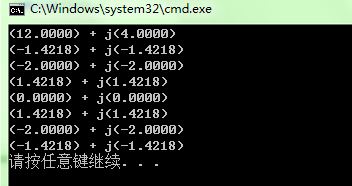程序原理来源:程佩青的《数字信号处理教程》中按时间抽选的基-2 FFT蝶形图
说明:(1)处理的对象是复数,使用的是纯C语言
(2)程序针对的是N=8的FFT
(3)因为是按时间抽选,所以输入为倒位序,输出为正常序,因此输入数据要进行倒位序
请注意后面的更正!!!
【.c文件】
#include "fft.h"
complex WN0 = {1,0};
complex WN1 = {0.7109, -0.7109};
complex WN2 = {0,-1};
complex WN3 = {-0.7109,-0.7109};
complex ComplexMul(complex c1, complex c2)
{
complex r;
r.re = c1.re*c2.re - c1.im*c2.im; //Re
r.im = c1.re*c2.im + c1.im*c2.re; //Im
return r;
}
complex ComplexAdd(complex c1, complex c2)
{
complex r;
r.re = c1.re + c2.re;
r.im = c1.im + c2.im;
return r;
}
complex ReverseComplex(complex c)
{
c.re = -c.re;
c.im = -c.im;
return c;
}
/*
* 8点基-2时间FFT算法
*/
void fft(complex *x, complex *r)
{
complex temp1[8];
complex temp2[8];
temp1[0] = x[0];
temp1[1] = ComplexMul(x[1], WN0);
temp1[2] = temp1[2] = x[2];
temp1[3] = ComplexMul(x[3], WN0);
temp1[4] = x[4];
temp1[5] = ComplexMul(x[5], WN0);
temp1[6] = x[6];
temp1[7] = ComplexMul(x[7], WN0);
temp2[0] = ComplexAdd(temp1[0],temp1[1]);
temp2[1] = ComplexAdd(temp1[0],ReverseComplex(temp1[1]));
temp2[2] = ComplexAdd(temp1[2],temp1[3]);
temp2[3] = ComplexAdd(temp1[2],ReverseComplex(temp1[3]));
temp2[4] = ComplexAdd(temp1[4],temp1[5]);
temp2[5] = ComplexAdd(temp1[4],ReverseComplex(temp1[5]));
temp2[6] = ComplexAdd(temp1[6],temp1[7]);
temp2[7] = ComplexAdd(temp1[6],ReverseComplex(temp1[7]));
temp2[2] = ComplexMul(temp2[2], WN0);
temp2[3] = ComplexMul(temp2[3], WN2);
temp2[6] = ComplexMul(temp2[6], WN0);
temp2[7] = ComplexMul(temp2[7], WN2);
temp1[0] = ComplexAdd(temp2[0],temp2[2]);
temp1[1] = ComplexAdd(temp2[1],temp2[3]);
temp1[2] = ComplexAdd(temp2[0],ReverseComplex(temp2[2]));
temp1[3] = ComplexAdd(temp2[1],ReverseComplex(temp2[3]));
temp1[4] = ComplexAdd(temp2[4],temp2[6]);
temp1[5] = ComplexAdd(temp2[5],temp2[7]);
temp1[6] = ComplexAdd(temp2[4],ReverseComplex(temp2[6]));
temp1[7] = ComplexAdd(temp2[5],ReverseComplex(temp2[7]));
temp1[4] = ComplexMul(temp1[4], WN0);
temp1[5] = ComplexMul(temp1[5], WN1);
temp1[6] = ComplexMul(temp1[6], WN2);
temp1[7] = ComplexMul(temp1[7], WN3);
r[0] = ComplexAdd(temp1[0], temp1[4]);
r[1] = ComplexAdd(temp1[1], temp1[5]);
r[2] = ComplexAdd(temp1[2], temp1[6]);
r[3] = ComplexAdd(temp1[3], temp1[7]);
r[4] = ComplexAdd(temp1[0], ReverseComplex(temp1[4]));
r[5] = ComplexAdd(temp1[1], ReverseComplex(temp1[5]));
r[6] = ComplexAdd(temp1[2], ReverseComplex(temp1[6]));
r[7] = ComplexAdd(temp1[3], ReverseComplex(temp1[7]));
}
/*
* 倒位序变换
*/
void BitReverse(complex *x, complex *r, uint8 n, uint8 l)
{
uint8 i = 0;
uint8 j = 0;
uint8 stk = 0;
for(i=0; i<n; i++)
{
stk = 0;
j = 0;
do
{
stk |= (i>>(j++)) & 0x01;
if(j<l)
{
stk <<= 1;
}
}while(j<l);
if(stk < n) /* 满足倒位序输出 */
{
r[stk] = x[i];
}
}
}
int main(void)
{
complex a[8] = {{1,0}, {1,0}, {2,1}, {2,1}, {2,1}, {2,1}, {1,0}, {1,0}};
complex r[8];
int i = 0;
BitReverse(a, a, 8, 3); //倒位序
fft(a, r);
for(i=0; i<8; i++)
{
printf("(%.4f) + j(%.4f)\n", r[i].re, r[i].im);
}
return 0;
}
【头文件“fft.h”】
#ifndef _FFT_H
#define _FFT_H
#include <stdio.h>
typedef unsigned int uint16u;
typedef unsigned char uint8;
typedef unsigned long uint32;
typedef int sint16;
typedef char sint8;
typedef long sint32;
typedef float fp32;
typedef double fp64;
#define FFT_N (8) //8点FFT
typedef struct Complex
{
fp32 re;
fp32 im;
} complex; //复数 FFT中的一个节点单元
//声明
complex WN0;
complex WN1;
complex WN2;
complex WN3;
complex ComplexMul(complex c1, complex c2);
complex ComplexAdd(complex c1, complex c2);
complex ReverseComplex(complex c);
void fft(complex *x, complex *r);
void BitReverse(complex *x, complex *r, uint8 n, uint8 l);
#endif

致歉及更正(2013.08.06)
上面算法中的BitReverse调用有一些问题,上面的BitReverse函数中的参数x与r不能传入相同的参数,从而上面的结果是有误的。
更正如下:
我将BitReverse作了修改,使用了一个局部的temp变量,下面的代码能对形参x和r传入相同的参数,其它不用修改,
/*
* Bit Reverse
* === Input ===
* x : complex numbers
* n : nodes of FFT. @N should be power of 2, that is 2^(*)
* l : count by bit of binary format, @l=CEIL{log2(n)}
* === Output ===
* r : results after reversed.
* Note: I use a local variable @temp that result @r can be set
* to @x and won't overlap.
*/
static void BitReverse(complex *x, complex *r, int n, int l)
{
int i = 0;
int j = 0;
short stk = 0;
static complex *temp = 0;
temp = (complex *)malloc(sizeof(complex) * n);
if (!temp) {
return;
}
for(i=0; i<n; i++) {
stk = 0;
j = 0;
do {
stk |= (i>>(j++)) & 0x01;
if(j<l)
{
stk <<= 1;
}
}while(j<l);
if(stk < n) { /* 满足倒位序输出 */
temp[stk] = x[i];
}
}
/* copy @temp to @r */
for (i=0; i<n; i++) {
r[i] = temp[i];
}
free(temp);
}最终正确的结果(使用matlab验证过无误)是

更多详细进一步的有关FFT的信息参考http://blog.csdn.net/xiahouzuoxin/article/details/9790455。
在此对误导的过的朋友表示歉意!
分享到:



相关推荐
fft c语言实现,快速傅里叶运算的c语言实现
fft的c语言实现
采用频域分解法的快速傅里叶变化(FFT)进行了C语言的实现,可用于频域分析(如电力中的电压电流谐波分析)。
128点FFT的C语言实现,附详细的FFT实现过程讲解
FFT的C语言算法实现,FFT的C语言算法实现,FFT的C语言算法实现。
FFT算法的C语言实现,采用倒位序算法,蝶形运算实现谐波计算
C语言实现FFT,实测效果极好,可经过修改实现二维FFT,以及FFT反变换。
快速傅立叶变化的fft算法的C语言实现。
c语言实现64点FFT源代码,经上机检验,绝对可行。也可以计算IDFT。
快速傅里叶变换 (fast Fourier transform), 即利用计算机计算离散傅里叶变换(DFT...本程序以C语言为平台,实现了按时间抽取的基-2FFT算法(蝶形算法)。具体见https://blog.csdn.net/SXGY_07/article/details/87902235
用C语言实现FFT算法,主要是用倒位排序和蝶形算法。
C语言实现FFT变换
FFT算法的C语言实现 很好很强大 很不错的
C语言实现FFT算法,与Matlab结果一致,详情请见https://blog.csdn.net/weixin_43216875/article/details/103343416
c语言实现的fft算法,代码中先做码位置换,再做蝶形运算
一个利用C语言,仿真实现定点FFT算法的程序:)
通过C语言编写fft变换程序,实现信号的快速傅里叶变换